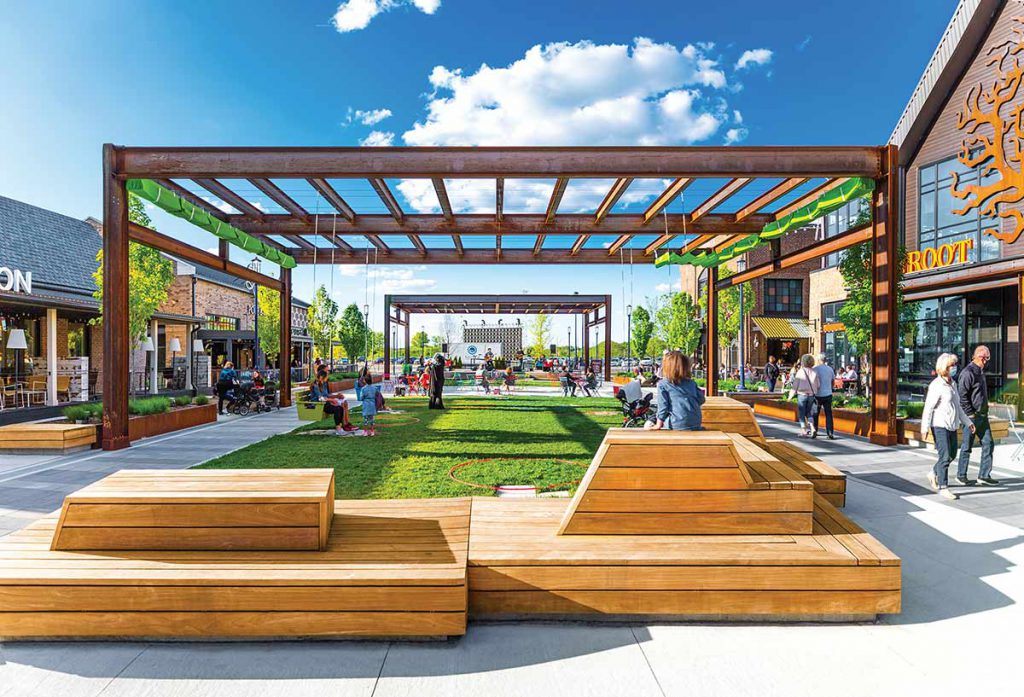By Mary Diduch, National Real Estate Investor
The sentiment among retail real estate professionals remained upbeat on the second day of exhibitions at this year’s RECon. Some attendees felt the “doom and gloom” of retail headlines seem to be, at least for the moment, somewhat in the past as retailers, owners and developers try to move the industry forward. Others, however, also continued to note that the pace of activity appeared slower than in previous years. In 2018, the conference fell over the Jewish holiday Shavuot, potentially impacting attendance levels. A representative for ICSC wrote in an email that total attendee count was not tabulated by Tuesday morning, though the organization had anticipated attendance to be on par with previous years.
Regardless of attendance levels, many attendees on Tuesday reported that meeting schedules were full and deals were getting done. For example, Joseph Coradino, chairman and CEO of mall owner PREIT, said his firm had a record high number of meetings with new tenants from a range of categories—a sign of a successful conference, he noted.
Here are some key points real estate professionals shared during the second day on the showroom floor.
- Competition is increasing for grocery-anchored properties, and it’s harder to shed power center assets. Many attendees pointed to the desire to focus more on incorporating grocery tenants into retail properties, and two chiefs of firms focused on grocery-anchored centers acknowledged the competition for them is getting tougher. Thomas McGuinness, president and CEO of InvenTrust Properties, a REIT that focuses on open-air centers, said his firm has increasingly focused more on grocery-anchored centers and has shed many power centers, which had faced headwinds similar to the mall sector in secondary and tertiary markets since 2015. “It’s not easy to sell power and to buy grocery,” he noted. McGuiness added, however, that there are cash-flow buyers looking to buy power centers in smaller markets before interest rates rise. Joel Murphy, CEO of New Market Properties, which owns grocery-anchored shopping centers in Sun Belt states, agreed that the competition to buy grocery-anchored centers is tough. This is even more the case as pension funds, looking to fill retail components in their allocation mandates, turn to necessity retail as a potentially safer bet than other retail properties, he added.
- The dissolution of the middle class is a key challenge. The gap between the top 10 percent of America’s wealth and the bottom 90 percent has been growing for decades, and it’s a fundamental challenge for the retail real estate industry, said Yaromir Steiner, founder and CEO of Steiner + Associates, a real estate developer. Consumers are still spending money, but the loss of a big chunk of America’s middle class has triggered the rise of discount brands and warehouse club retailers. Given these changes, the industry cannot be shocked that some malls are dying and value retailers like Dollar General are growing, Steiner noted. “This income shift is fundamental.”
- Malls will continue to shutter and evolve. America’s nearly 1,200 malls will likely be cut down to 600, according to Carl Tash, chief strategist at Starwood Retail Partners. And the malls that survive will be those that have, in some cases, transformed into completely different uses. Tash notes, for example, that one Starwood mall, Fair Lane Towne Center in Dearborn, Mich., saw nearby Ford Motor Corp.’s research and development division expand its offices into the mall, overtaking a vacant Lord & Taylor store. At another property in Nebraska, a local community college is weighing holding classes in a Bon-Ton location. Coradino, of PREIT, said his firm shed 17 malls in secondary and tertiary markets, which has helped to boost its sales to $385 per sq. ft. from $340 per sq. ft., and that the REIT continues to prune its portfolio where needed. “The mall space is changing at a blistering pace,” he noted. Other firms are also trying to shed properties, but Coradino said the buyer pool has shrunk and cap rates have risen. PREIT also continues to change the tenant composition at its malls, Coradino added, shifting from apparel retailers to mixed-use opportunities.
- Amazon’s acquisition of Whole Foods does not appear to be as disruptive to the grocery sector as originally thought—at least so far. The sense when Amazon announced its deal to buy grocery chain Whole Foods was that the move might trigger price reductions, according to McGuinness. But nearly a year after the announcement, that doesn’t appear to be the case, he said: There has been some price discounting, “but maybe not as material as we thought.” However, the partnership is still evolving. “I think it’s still new and they’re trying to figure it out,” McGuinness said. Murphy, of New Market Properties, said another initial reaction to the deal was that Amazon was going to disrupt the grocery sector like it did the bookstore industry. But that hasn’t happened yet either. Instead, the move has pushed other grocers, like Kroger and Publix, to innovate. “They woke up pretty quickly,” Murphy said.
- Publicly-traded retail REITs are being painted with a broad brush—and perhaps unfairly so. McGuinness said lower-tier malls and power centers may deserve some of the negative sentiment surrounding them, particularly as class-C and class-B malls are more than likely to go dark. That sentiment appears to be spilling into other retail REIT sub-sectors, yet the fundamentals of community shopping centers are still strong, he noted. “It’s just raining on all of retail, and the hope is there’s just kind of a bifurcation,” McGuiness said.
- Technology is key to the industry’s survival, but some are still slow to adopt. Many conference attendees pointed to the importance of adopting new technologies to help facilitate the merging of online and in-store sales. “Everything is about an experience, and speed and convenience,” said Jedd Nero, principal and executive managing director of New York City retail at Avison Young, a real estate services firm. However, not everyone is jumping to add the latest tools to their stores. Nero noted, for example, how the ICSC technology hub called the Innovation Exchange featured many new products to help the retail real estate business, but drew a sparse crowd. “This is what people are still not acknowledging and facing,” he said.






